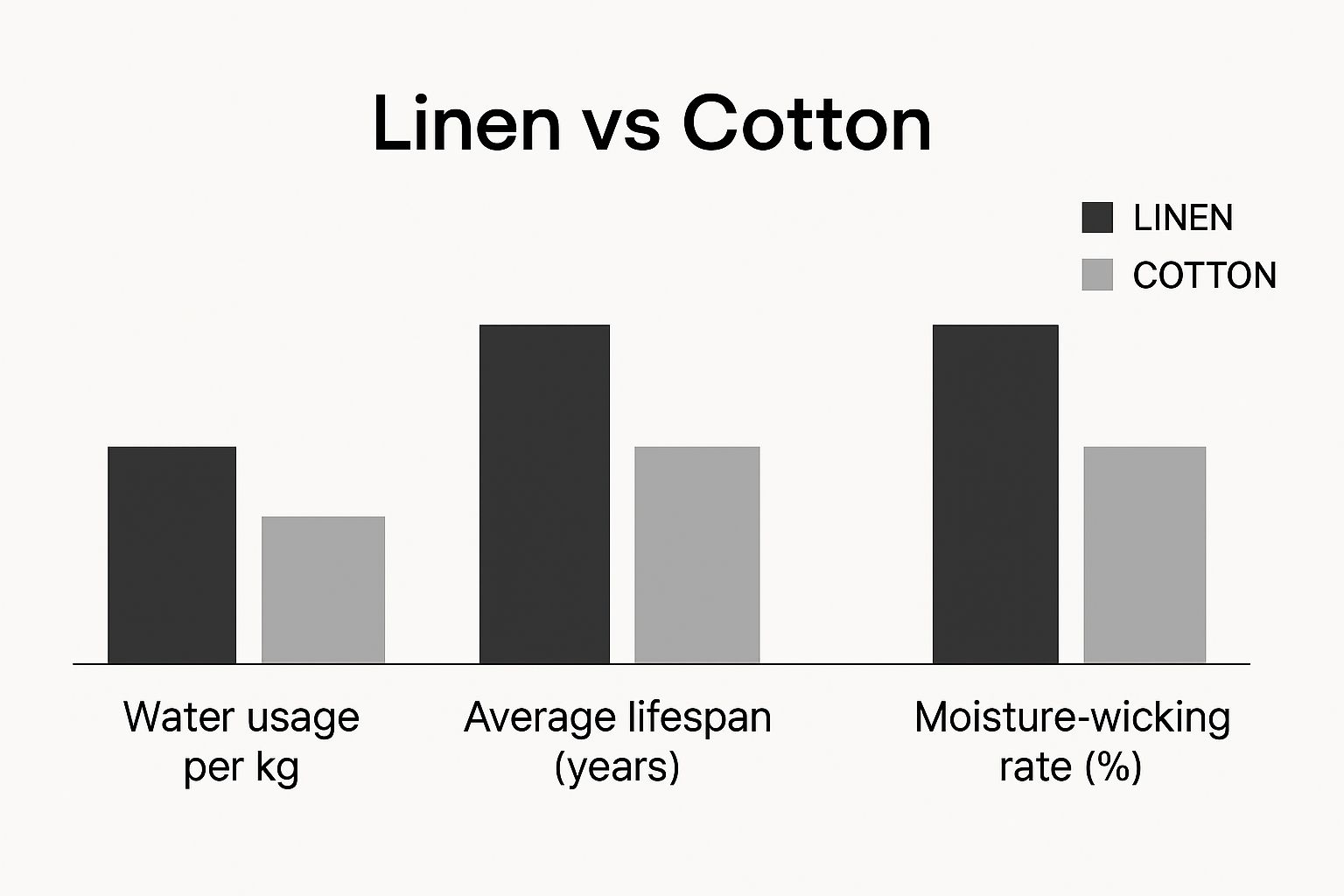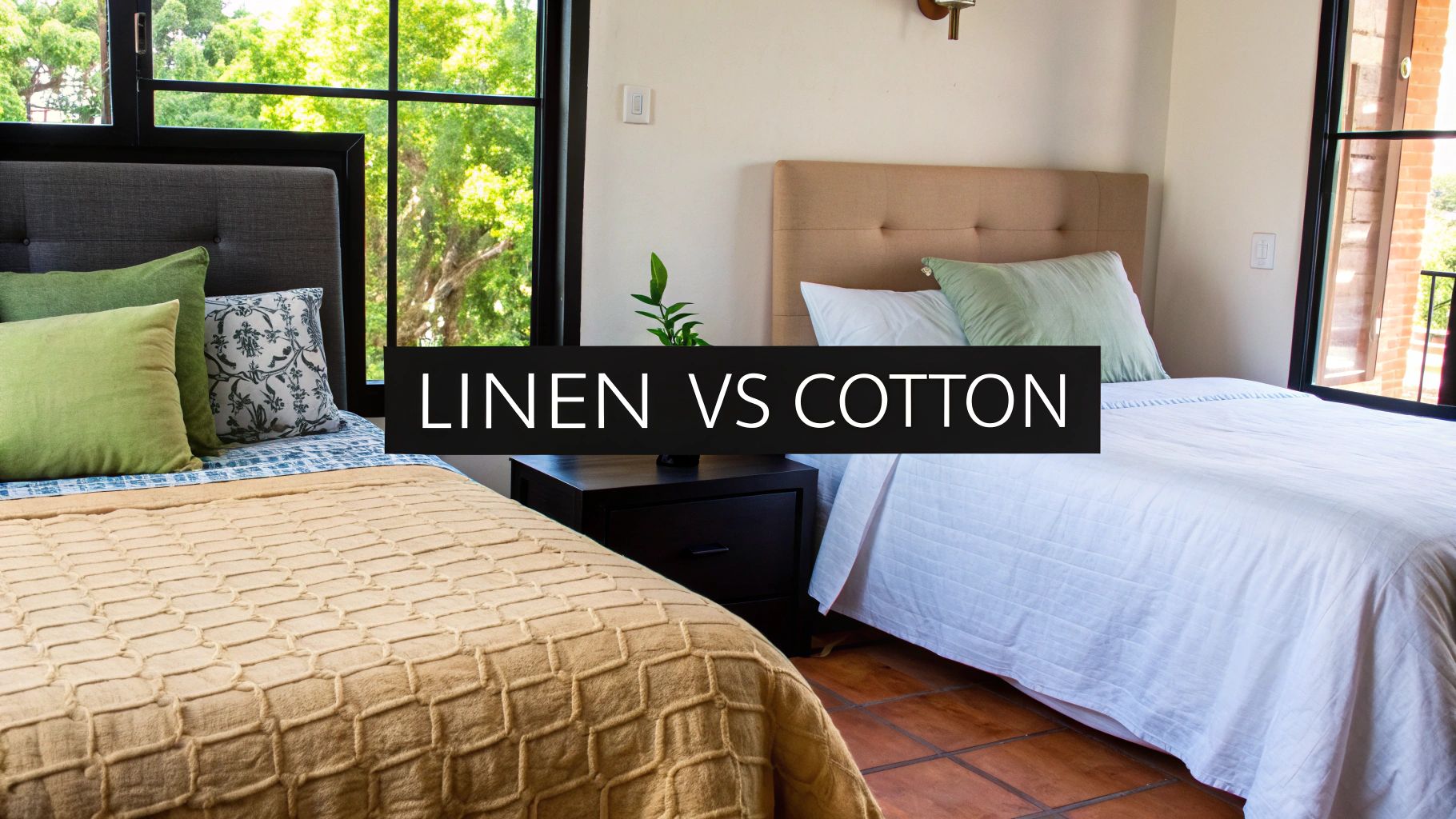Choosing new bedding can feel overwhelming, but the classic linen vs cotton debate often comes down to personal preference. Let's get straight to it. If you are a warm sleeper who loves a relaxed, lived in style that only gets better with age, linen is likely your perfect match. If you crave classic, consistent softness from the very first night, then high quality cotton is a brilliant option.
Linen vs Cotton: What’s the Real Difference?
When you are on the hunt for the perfect bedding, getting to grips with the fundamental differences between fabrics is the first step. Linen and cotton might both be natural, plant based materials, but they come from entirely different sources, which gives them their unique characteristics.
Linen is crafted from the long, strong fibres found inside the stalk of the flax plant. It is one of the oldest textiles in the world, valued for centuries for its incredible durability and breathability. Its fibres are naturally thicker and longer than cotton’s, which results in that distinctively crisp yet airy texture we know and love.
Cotton, on the other hand, comes from the soft, fluffy bolls surrounding the seeds of the cotton plant. It is renowned for its versatility and immediate softness, making it a hugely popular choice for bedding across the globe. The feel of cotton can also change dramatically depending on its weave, from the silky smoothness of sateen to the light crispness of percale.
Linen vs Cotton at a Glance
To make the choice a little easier, this table breaks down the main points of difference between these two fantastic fabrics. Think of it as a quick summary to guide you.
| Characteristic | Linen Bedding | Cotton Bedding |
|---|---|---|
| Initial Feel | Crisp and textured, softens beautifully with each wash. | Soft and smooth right from the first night. |
| Breathability | Exceptionally breathable and moisture wicking. | Good breathability, varies by weave (percale is cooler). |
| Durability | Extremely durable, can last for decades with proper care. | Very durable, though it can thin over time. |
| Appearance | Naturally relaxed with an elegant, crumpled look. | Smooth and crisp, offering a more polished finish. |
| Best For | Warm sleepers and those who love a lived in aesthetic. | Anyone who prioritises day one softness and a classic look. |
This table gives you a solid foundation, but a picture can often add more context.

As you can see, linen generally requires less water to produce and has a longer lifespan, making it a strong contender if sustainability is a key factor for you. Delving deeper into the best bed sheets material can help clarify which fabric truly aligns with your values and comfort needs.
How Linen and Cotton Bedding Actually Feel
The way your bedding feels against your skin is probably the single most important factor when choosing between linen and cotton. They are both natural and comfortable, but they offer vastly different experiences when you finally slip into bed. It is not just about softness, it is about texture, weight, and how the fabric drapes over you while you sleep.

This sensory difference is where the real debate comes alive. One is not inherently better, but one will almost certainly feel better to you.
The Unique Feel of Linen
When you first unbox a set of linen sheets, you might be a bit surprised. They do not have that immediate, silky smoothness of a high thread count cotton. Instead, new linen has a satisfyingly crisp, substantial feel, with a visible, almost rustic texture that hints at its natural origins.
That initial crispness is part of its character. Think of it like a quality pair of leather boots or your favourite denim jacket, it needs a bit of breaking in. With every wash, the flax fibres relax and soften, transforming the fabric into something incredibly supple and gentle against the skin. This is why linen lovers are so devoted, it truly becomes yours over time.
Its unique structure also gives linen a slightly heavier drape, but it never feels heavy or suffocating. It rests lightly on the body, allowing air to circulate freely, so you feel securely tucked in without any trapped heat.
Linen offers a living texture. It starts with a crisp, earthy feel and evolves into a buttery softness that only improves with age, making it a true long term investment in comfort.
The Familiar Comfort of Cotton
Cotton, on the other hand, delivers a more immediate and familiar kind of softness. The brilliant thing about cotton is that you can choose your tactile experience right from the first night, just by picking a different weave. It is a wonderfully dependable choice if you know exactly what you like.
A percale weave, for example, gives you that classic crisp, cool feeling often associated with luxury hotel bedding. It is lightweight and feels incredibly fresh and airy when you get into bed.
Then you have the sateen weave, which offers a completely different sensation. It is woven to produce a much silkier, smoother surface with a subtle lustre. If you love the feeling of fabric gliding over your skin, sateen provides a more sumptuous and cosy feel from the get go.
Let’s look at how these textures play out in real life.
- For the traditionalist: If you love the reliable softness and crisp finish of classic bedding, cotton percale is a fantastic choice. It delivers that 'new sheets' feeling every time.
- For the luxury seeker: If you want your bed to feel like a silky cocoon, cotton sateen offers that immediate sense of indulgence and warmth.
- For the patient comfort lover: If you appreciate things that get better with age and have a more natural, lived in feel, linen will reward your patience with unparalleled softness down the line.
Ultimately, the choice comes down to personal preference. Are you looking for the instant gratification of a predictably soft fabric, or do you prefer one that evolves with you, developing a unique character and comfort that just gets better year after year?
Breathability for a Comfortable Night's Sleep
Waking up hot and tangled in damp sheets is one of the quickest ways to ruin a good night's rest. Your bedding plays a massive role in how well your body regulates its temperature while you sleep. When it comes to linen versus cotton, this is where one of the most significant differences truly comes to light, making one fabric a clear winner for certain people.

Choosing the right material is not just about the season, it is about curating a personal microclimate that keeps you sound asleep all year. Let's dig into how linen and cotton each tackle the crucial job of keeping you at that just right temperature.
Linen: The Natural Air Conditioner
Linen is an absolute champion of temperature regulation, making it a dream for anyone who runs a bit warm at night. This is not just marketing fluff, it is down to the unique structure of the flax fibres it is made from. These fibres are naturally hollow, which allows air to circulate with incredible ease.
This built in ventilation system is brilliant for two reasons. First, it lets excess body heat escape, preventing that stuffy, trapped feeling. Second, it is fantastic at moisture wicking, pulling perspiration away from your skin and releasing it into the air. This keeps you feeling comfortably dry, not clammy, even on the stickiest nights.
It is the difference between wearing a breezy linen shirt on a summer day versus a standard cotton t shirt. The improvement in comfort is immediate and undeniable.
Linen's looser weave and hollow fibres create a natural climate control system for your bed. It actively works to keep you cool and dry, making it the perfect partner for hot sleepers or sweltering summer months.
Cotton: Versatility for Every Season
Cotton is, of course, also a breathable natural fibre, which is why it has been the go to for bedding for generations. Its performance, however, really depends on the weave. The way it is woven determines how tightly the threads are packed together, which directly affects airflow.
This versatility is one of cotton's greatest strengths, giving you options for year round comfort.
- Percale Weave: This is a simple, plain weave that creates a light, crisp fabric. It feels cool against the skin and allows for great air circulation, making it an excellent cotton choice for summer or for those who prefer to sleep cool.
- Sateen Weave: This weave is denser, with more threads sitting on the surface. While this results in a silky smooth, luxurious feel, it also makes the fabric less breathable and warmer to sleep under. It is a wonderfully cosy option for colder months or for people who are always feeling chilly.
Cotton is a solid all rounder, but it just does not have the same moisture wicking superpower as linen. On a particularly warm night, a denser cotton weave might start to feel a little damp if you sweat, whereas linen would almost certainly remain dry and comfortable.
Making the Right Choice for Your Sleep
So, which one is right for you? It really boils down to how you sleep and what you need from your sheets.
Choose linen if:
- You are a naturally warm sleeper and often find yourself kicking off the covers.
- You experience night sweats or live in a particularly humid climate.
- You want one set of bedding that excels in summer but still feels comfortable in winter.
Choose cotton if:
- You like having the flexibility of different weaves for different seasons.
- You sleep at a fairly average temperature and do not often overheat.
- You prefer a cosier, warmer feel in winter, in which case, a sateen weave is perfect.
Ultimately, both fabrics can give you a comfortable night's sleep, but they get there in different ways. In the breathability contest of linen vs cotton, linen is the undisputed champion of cool, dry comfort, while cotton offers reliable, adaptable performance for every preference.
Durability and How Your Bedding Will Age
Good bedding is an investment, so it is only natural to wonder how long it will last. When you are choosing between linen and cotton, you are not just deciding on comfort for tonight, but for years to come. While both are impressively hardwearing natural fabrics, one definitely has the edge in the long game.

This is where the linen versus cotton debate often finds a clear winner. If you see your bedding as something to be cherished for years, even decades, then understanding how each fabric holds up to daily life, washing, and time itself is crucial.
The Enduring Strength of Linen
Linen is legendary for its strength. In fact, it is one of the strongest natural fibres in the world. This incredible resilience comes from the long, robust fibres of the flax plant, which are noticeably thicker and longer than those from the cotton plant.
What does this mean for your bed sheets? It means linen is incredibly resistant to pilling, thinning, and tearing. But it does something else quite remarkable. Instead of wearing out with use and washing, it wears in. With every wash cycle, the fibres relax and soften, making the fabric stronger and more supple.
It is this unique quality that makes vintage linen so highly prized. This is a fabric that genuinely gets better with age, often lasting for decades and sometimes even passed down through generations as a family heirloom.
The Dependable Nature of Cotton
Let's be clear, high quality cotton is also very durable, especially long staple varieties like Egyptian or Pima. A well made set of cotton sheets will serve you beautifully for many years, providing consistent softness and comfort. It holds colour brilliantly and stands up to frequent washing, making it a great workhorse for a busy family home.
Over a very long period, however, cotton fibres can be more susceptible to wear. After hundreds of washes, you might start to see the fabric thinning or becoming more prone to tearing, particularly in high friction areas. While it is a wonderfully reliable choice, it does not quite share linen’s unique ability to improve with every wash.
Linen is an investment in future comfort. It gets softer and stronger with every wash, while cotton offers dependable softness from day one but may show its age more quickly over the years.
A Look Back at Britain's Textile History
The enduring nature of these fibres is not a new discovery. Both have a rich history in British homes that predates modern manufacturing. During the 18th century, linen production was a cornerstone of the British economy, especially in rural areas where families spun and wove flax by hand. Before cotton began to dominate, England was producing around 3 million yards of linen annually by the mid 1700s. You can discover more fascinating details about this history in this study of the 18th-century British Isles.
This long history speaks volumes about the fabric’s inherent durability. It was valued for everything from clothing to household textiles precisely because it was built to last.
A Practical Comparison of Longevity
So, what can you realistically expect from your bedding? Let's break it down to help you visualise how each fabric might age in your home.
- Linen's Lifespan: With proper care, linen sheets can easily last for 20 to 30 years, sometimes even longer. They will become noticeably softer after just a few washes and will only continue to improve over their entire lifespan.
- Cotton's Lifespan: A quality set of cotton sheets typically lasts between 3 to 5 years. Premium cottons might extend this to over a decade, but they will eventually start showing signs of wear.
If you are looking for bedding you can buy once and love for a lifetime, linen is the clear frontrunner. Its ability to transform and improve with age makes it a truly worthwhile investment in years of comfortable sleep.
Practical Tips for Washing and Care
Knowing how to properly care for your bedding is the secret to making it last. Whether you have chosen the laid back appeal of linen or the classic crispness of cotton, a few simple steps are all it takes to keep them feeling incredible for years.
The good news? Luxurious fabrics do not demand complicated routines. It is all about a straightforward approach that protects the fibres and enhances their best qualities, ensuring your sheets look and feel their best, wash after wash.
Caring for Your Linen Bedding
The real beauty of linen lies in how wonderfully low maintenance it is. This is a fabric that thrives on a simple routine, actually getting softer and more supple each time you wash it. Forget fussy instructions, looking after linen is about working with its naturally relaxed character, not against it.
To get the very best results, just follow these easy steps.
- Wash Gently: Opt for a gentle machine cycle with cool or lukewarm water, ideally around 30°C. This is plenty warm enough to clean effectively without putting any stress on the delicate flax fibres.
- Use a Mild Detergent: A gentle, natural detergent is your best friend here. Steer clear of harsh chemicals or bleach, as they can weaken the fibres and dull the colour over time.
- Do Not Overcrowd the Machine: Always give your linen sheets plenty of room to move around in the drum. This not only ensures a more thorough clean but also helps prevent excessive creasing.
The most common question people ask about linen is how to deal with its natural tendency to crumple. Honestly, the best approach is to simply embrace it.
Linen's relaxed, slightly crumpled look is a huge part of its charm. It is meant to look lived in and inviting, not perfectly pressed. Trying to fight it with a hot iron often takes away from its unique aesthetic.
If you really prefer a smoother finish without the fuss of ironing, just give your sheets a good, firm shake while they are damp before hanging them to dry. You can also tumble dry them on a low heat setting, but make sure to pull them out while they are still slightly damp. This technique naturally relaxes the fibres and minimises wrinkles. You can find more advice on looking after luxurious bed linens to keep them feeling wonderful.
Keeping Your Cotton Bedding Perfect
Cotton is incredibly resilient and easy to care for, but using the right technique will preserve its softness and colour for much longer. The main thing to remember is to avoid high heat, which can cause the fibres to shrink and colours to fade over time.
For cotton sheets that stay vibrant and soft, this is all you need to do.
Best Washing Practices for Cotton
Always check the care label first, but as a general rule, a 40°C wash is perfect for cotton bedding. This temperature cleans thoroughly while still being gentle on the fabric. While an occasional wash at 60°C is fine for a deeper clean, sticking to lower temperatures for regular washes will significantly prolong the life of your sheets.
Just as with linen, use a gentle detergent and avoid overloading your washing machine. Tumble drying on a low setting will help keep your cotton feeling soft and fluffy. For that crisp, hotel style finish, iron your cotton sheets while they are still slightly damp as you will get the best results with minimal effort. Following these simple tips means both your linen and cotton will stay beautiful for years to come.
Making the Right Choice for Your Home
So, which is it to be: linen or cotton? After weighing up the feel, breathability, and durability, the final decision really boils down to your personal definition of comfort. It is about matching the fabric's unique qualities to your own lifestyle.
Let's move past the technical specs and think about how these fabrics actually perform in real life. By considering a few common scenarios, you can confidently decide which material will bring you the best night's sleep.
Scenarios to Guide Your Decision
Picture your ideal bedtime. Are you dreaming of a cool, airy sanctuary or a soft, snuggly cocoon? Your answer here is probably the biggest clue.
- For the Warm Sleeper: If you find yourself kicking off the covers or waking up feeling too warm, linen is your perfect match. Its natural breathability and moisture wicking properties are second to none, helping to regulate your temperature all night long.
- For the Lover of Classic Luxury: If your idea of heaven is slipping into sheets that feel like a five star hotel bed, then high quality cotton is an excellent choice. A sateen weave will give you that silky smooth finish, while a percale weave offers that classic crisp, cool feel.
Your bedding is more than just a functional item, it is a key part of your home’s aesthetic and a nightly comfort ritual. Choose the fabric that not only feels right but also fits seamlessly into the way you live.
Practicality for Family Life
Day to day life plays a huge part in this decision, too. For a busy family home where bedding sees a lot of use and frequent washes, durability and ease of care are paramount.
Cotton has a long and storied history as a dependable textile in Britain. During the Industrial Revolution, its production exploded, with imports soaring from 56 million pounds in 1800 to over 660 million pounds by 1850, cementing its place in households across the country. To explore this fascinating history, read more about Britain's historic cotton industry. This legacy of reliability makes cotton a fantastically practical choice.
On the other hand, while linen requires a bigger initial investment, its incredible durability means it can withstand countless washes, often lasting for decades. This actually makes it a brilliant long term, cost effective option.
Finally, do not forget how your sheets will work with the rest of your bed coverings. Understanding the different types of bedding can help you create your perfect sleep setup. You can learn more by reading our guide on what duvets and covers are.
By carefully weighing up your personal comfort, aesthetic preferences, and practical household demands, you will find the bedding that truly feels like it was made just for you.
Got Questions? We've Got Answers
Let's tackle some of the common questions that pop up when you are weighing up linen against cotton. Making the right choice is all about understanding the details, so here is some straightforward advice to clear up any lingering doubts.
Which Fabric Is More Sustainable?
This is a hot topic, and it is not always a simple answer. On the whole, linen usually comes out ahead. It is derived from the flax plant, a resilient crop that thrives in poor soil and needs significantly less water and fewer pesticides than standard cotton.
The historical context is quite telling. Back in the 1840s, Britain's cotton industry was a behemoth, requiring raw materials from over 5.1 million acres of land abroad. This massive footprint stands in stark contrast to the more modest, localised flax cultivation for linen. If you are curious about the deeper ecological history, this paper on Britain's textile industry is a fascinating read.
But it is not a clear cut win for linen today. If you opt for certified organic cotton, the environmental gap narrows considerably. Organic farming methods champion water conservation and steer clear of harsh chemicals. Ultimately, both are natural, biodegradable fibres, making either one a far better choice than any synthetic material.
Are Linen Sheets Really Worth the Price?
It is true, linen bedding asks for a higher upfront investment. But think of it less as a purchase and more as a long term addition to your home. The standout feature of linen is its incredible durability, as a well cared for set can last for decades, easily outliving multiple sets of cotton sheets.
Here is a practical way to look at it.
- Linen: A one time investment that will reward you by getting softer and stronger for 20 to 30 years.
- Cotton: A more budget friendly choice that delivers superb comfort for 3 to 5 years before it is time for a new set.
The true worth of linen is found in its longevity and its unique ability to get better with every wash. If you are looking for bedding to treasure for a lifetime, its enduring quality makes it an exceptional choice.
Can I Mix Linen and Cotton Bedding?
Absolutely! In fact, mixing and matching is a fantastic way to get the best of both worlds and create a really inviting, layered aesthetic for your bed. One of the most popular combinations is a crisp cotton fitted sheet paired with a soft, airy linen duvet cover.
This setup gives you that smooth, cool feel of cotton right against your skin, while the linen top layer works its magic with temperature regulation. It is a brilliant, practical solution that also introduces a lovely textural contrast to your bedroom décor.



Share:
Best Material for Bed Sheets: Your Guide to a Better Night's Sleep
What’s the Best Thread Count for Sheets? (The Truth Every Aussie Should Know)